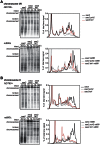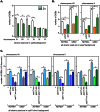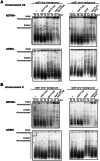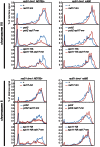Direct and indirect control of the initiation of meiotic recombination by DNA damage checkpoint mechanisms in budding yeast
- PMID: 23762445
- PMCID: PMC3677890
- DOI: 10.1371/journal.pone.0065875
Direct and indirect control of the initiation of meiotic recombination by DNA damage checkpoint mechanisms in budding yeast
Abstract
Meiotic recombination plays an essential role in the proper segregation of chromosomes at meiosis I in many sexually reproducing organisms. Meiotic recombination is initiated by the scheduled formation of genome-wide DNA double-strand breaks (DSBs). The timing of DSB formation is strictly controlled because unscheduled DSB formation is detrimental to genome integrity. Here, we investigated the role of DNA damage checkpoint mechanisms in the control of meiotic DSB formation using budding yeast. By using recombination defective mutants in which meiotic DSBs are not repaired, the effect of DNA damage checkpoint mutations on DSB formation was evaluated. The Tel1 (ATM) pathway mainly responds to unresected DSB ends, thus the sae2 mutant background in which DSB ends remain intact was employed. On the other hand, the Mec1 (ATR) pathway is primarily used when DSB ends are resected, thus the rad51 dmc1 double mutant background was employed in which highly resected DSBs accumulate. In order to separate the effect caused by unscheduled cell cycle progression, which is often associated with DNA damage checkpoint defects, we also employed the ndt80 mutation which permanently arrests the meiotic cell cycle at prophase I. In the absence of Tel1, DSB formation was reduced in larger chromosomes (IV, VII, II and XI) whereas no significant reduction was found in smaller chromosomes (III and VI). On the other hand, the absence of Rad17 (a critical component of the ATR pathway) lead to an increase in DSB formation (chromosomes VII and II were tested). We propose that, within prophase I, the Tel1 pathway facilitates DSB formation, especially in bigger chromosomes, while the Mec1 pathway negatively regulates DSB formation. We also identified prophase I exit, which is under the control of the DNA damage checkpoint machinery, to be a critical event associated with down-regulating meiotic DSB formation.
Conflict of interest statement
Figures




References
-
- Petronczki M, Siomos MF, Nasmyth K (2003) Un menage a quatre: the molecular biology of chromosome segregation in meiosis. Cell 112: 423–440. - PubMed
-
- Keeney S (2001) Mechanism and control of meiotic recombination initiation. Curr Top Dev Biol 52: 1–53. - PubMed
-
- Sun H, Treco D, Szostak JW (1991) Extensive 3′-overhanging, single-stranded DNA associated with the meiosis-specific double-strand breaks at the ARG4 recombination initiation site. Cell 64: 1155–1161. - PubMed
Publication types
MeSH terms
Substances
Grants and funding
LinkOut - more resources
Full Text Sources
Other Literature Sources
Molecular Biology Databases
Research Materials
Miscellaneous

